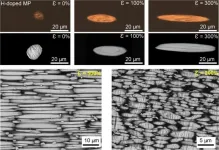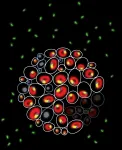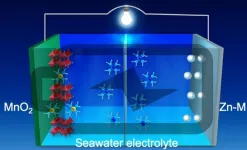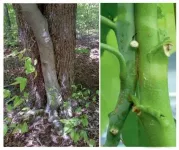Liquid metal ink liberates form
2021-01-11
(Press-News.org) Today's electronic devices strive for new form factors - to make them foldable, stretchable, and deformable. To produce such devices that are highly stretchable or deformable, it is necessary to develop electrodes and circuit lines whose electrical properties can withstand harsh deformation or mechanical damage. To this, POSTECH-Yonsei University joint research team has recently developed liquid metal ink to accelerate printed electronic devices that can be changed into any shape.
Professor Unyong Jeong and Dr. Selvaraj Veerapandian of POSTECH's Department of Materials Science and Engineering, with Professor Aloysius Soon and Dr. Woosun Jang of Yonsei University's Department of Materials Science and Engineering, have developed liquid metal microparticles with high conductivity and viscoplasticity. These research findings were published in the authoritative international journal Nature Materials on January 4, 2021.
Electronic devices conventionally use electrodes and circuit lines made of hard metals such as gold, silver, or copper. However, such metal substrates crack and lose their electrical conductivity upon external pressure and elongation, making them unfit to use in deformable electronic devices. On the contrary, liquid metals - which flow like a liquid at room temperature and are easily deformable and highly conductive - have attracted great attention for their potential applicability in stretchable circuit lines. However, when these liquid metals are made into ink, an insulating oxide skin forms on the surface that removes their conductivity after being printed.
The joint research team devised a method to convert the oxide film of the liquid metal microparticles into a conductor by doping hydrogen ions into the films. To theoretically verify the conductivity of the oxide film via hydrogen doping, the team used quantum mechanics-based material simulations to confirm that the hydrogen-doped indium oxides or gallium oxides can have similar electrical conductivity to the indium tin oxide (ITO) electrodes currently being utilized in transparent electrodes. The researchers additionally confirmed that the hydrogen-doped oxide film with polymer adsorption to the surface had viscoplasticity that could withstand about 300% elongation strain without breakage.
This new liquid metal ink containing the hydrogen-doped liquid metal microparticles allowed direct printing of 3D circuit lines on various stretchable substrates. Since the microparticles could change the shape upon deformation while maintaining high conductivity, the printed electrodes and circuit lines displayed negligible change in resistance even when stretched over 500% and maintained electrical properties even in harsh environments like high humidity, high temperatures or severe mechanical damage. This innovative technology is anticipated to enable the development of next-generation stretchable devices.
"Such high viscoplasticity of metal oxides have never been studied so far," remarked Professor Aloysius Soon of Yonsei University. "What began as a study on viscoplasticity of conductive oxide-skin has opened up the possibilities of developing ductile metal oxides of semiconductors and insulators."
POSTECH's research team led by Professor Unyong Jeong is working toward commercialization of highly stretchable circuits using the newly developed ink and printing technology. Since their liquid metal ink allows to use traditional printing methods for fabrication of complex 3D circuits without leakage current, the new ink is projected to be highly applicable in other industries like robotics, electronic skins, and wearable devices through 3D printing.
"The ultimate goal of this research is to develop stretchable and foldable 3D electronic devices that retain their electronic property even in harsh conditions or mechanical damage," added Professor Unyong Jeong.
INFORMATION:
The research was conducted with the support from the Center for Advanced Soft-Electronics under the Global Frontier Project and the Creative Materials Discovery Program funded by the National Research Foundation of Korea (NRF) and the Ministry of Science, ICT and Future Planning, and from and the Korea Research Institute of Chemical Technology (KRICT).
[Attachments] See images for this press release:

ELSE PRESS RELEASES FROM THIS DATE:
2021-01-11
NIH-supported pilot study found team-based approach may improve buprenorphine care.
WHAT:
A collaborative approach to treating opioid use disorder that relies heavily on community pharmacists is feasible and may increase adherence and participant satisfaction, according to a pilot study published today in Addiction. The study was supported by the National Institute on Drug Abuse (NIDA), part of the National Institutes of Health, through the NIDA Center for the Clinical Trials Network.
Most people with opioid use disorder who would benefit from medication do not receive it. Buprenorphine is a safe and effective ...
2021-01-11
DALLAS - Jan. 11, 2021 - A set of biomarkers not traditionally associated with cell fate can accurately predict how genetically identical cells behave differently under stress, according to a UT Southwestern study. The findings, published by Cell Reports as a Dec. 1 cover story, could eventually lead to more predictable responses to pharmaceutical treatments.
Groups of the same types of cells exposed to the same stimuli often display different responses. Some of these responses have been linked to slight differences in genetics between individual cells. However, even genetically identical cells can diverge in ...
2021-01-11
As the planet continues to warm, the twin challenges of diminishing water supply and growing energy demand are intensifying. But because water and energy are inextricably linked, as we try to adapt to one challenge - say, by getting more water via desalination or water recycling - we may be worsening the other challenge by choosing energy-intensive processes.
So, in adapting to the consequences of climate change, how can we be sure that we aren't making problems worse?
Now, researchers at the Department of Energy's Lawrence Berkeley National Laboratory (Berkeley Lab), UC Berkeley, and UC Santa Barbara have developed a science-based analytic framework to evaluate such complex connections between water and energy, and options for adaptations in response to an evolving ...
2021-01-11
CORVALLIS, Ore. - Researchers in the Oregon State University College of Engineering have developed a battery anode based on a new nanostructured alloy that could revolutionize the way energy storage devices are designed and manufactured.
The zinc- and manganese-based alloy further opens the door to replacing solvents commonly used in battery electrolytes with something much safer and inexpensive, as well as abundant: seawater.
Findings were published today in Nature Communications.
"The world's energy needs are increasing, but the development of next-generation electrochemical energy storage systems with high energy density and long cycling life ...
2021-01-11
PULLMAN, Wash. - Biomarkers in human sperm have been identified that can indicate a propensity to father children with autism spectrum disorder. These biomarkers are epigenetic, meaning they involve changes to molecular factors that regulate genome activity such as gene expression independent of DNA sequence, and can be passed down to future generations.
In a study published in the journal Clinical Epigenetics on Jan. 7, researchers identified a set of genomic features, called DNA methylation regions, in sperm samples from men who were known to have autistic children. Then in a set of blind tests, the researchers were able to use the presence of these features to determine whether other men had fathered autistic children with 90% ...
2021-01-11
New research shows people who pursue meaningful activities - things they enjoy doing - during lockdown feel more satisfied than those who simply keep themselves busy.
The study, published in PLOS ONE, shows you're better off doing what you love and adapting it to suit social distancing, like swapping your regular morning walk with friends for a zoom exercise session.
Simply increasing your level of activity by doing mindless busywork will leave you unsettled and unsatisfied.
Co-lead researcher Dr Lauren Saling from RMIT University in Melbourne, Australia said while novelty lockdown activities - like baking or painting - have their place, trying to continue what you enjoyed before lockdown can be more rewarding.
"Busyness might be distracting but it won't necessarily be fulfilling," ...
2021-01-11
COVID-19 infections are once again rising at an alarming rate in San Francisco's Latinx community, predominantly among low-income essential workers, according to results of a massive community-based testing blitz conducted before and after the Thanksgiving holiday by Unidos En Salud -- a volunteer-led partnership between the Latino Task Force for COVID-19 (LTF), UC San Francisco , the Chan Zuckerberg Biohub (CZ Biohub), and the San Francisco Department of Public Health (SFDPH).
Unidos En Salud launched their "Healthy Holidays" initiative the weekend before Thanksgiving (Nov. 22-24) in San Francisco's Mission District, where they have been perfecting their community-based surveillance testing ...
2021-01-11
The genetic material of plants, animals and humans is well protected in the nucleus of each cell and stores all the information that forms an organism. For example, information about the size or color of flowers, hair or fur is predefined here. In addition, cells contain small organelles that contain their own genetic material. These include chloroplasts in plants, which play a key role in photosynthesis, and mitochondria, which are found in all living organisms and represent the power plants of every cell. But is the genetic material actually permanently stored within one cell? No! As so far known, the genetic material can migrate from cell to cell and thus even be exchanged between different organisms. Researchers at the Max Planck Institute of Molecular Plant Physiology (MPI-MP) ...
2021-01-11
We are fascinated by machines that can control cars, compose symphonies, or defeat people at chess, Go, or Jeopardy! While more progress is being made all the time in Artificial Intelligence (AI), some scientists and philosophers warn of the dangers of an uncontrollable superintelligent AI. Using theoretical calculations, an international team of researchers, including scientists from the Center for Humans and Machines at the Max Planck Institute for Human Development, shows that it would not be possible to control a superintelligent AI. The study was published in the Journal of Artificial Intelligence Research.
Suppose someone ...
2021-01-11
When an accident occurs, the reactions of bystanders are important. Researchers have studied whether laypeople realise the severity of the situation when someone in their proximity begins to bleed, and whether they can estimate how much the person is bleeding. The results show a discrepancy related to the victim's gender: for a woman losing blood, both blood loss and life-threatening injuries were underestimated. The study has been published in the scientific journal PLoS One.
Researchers from Linköping University and Old Dominion University in the United States wanted to study the ability of laypeople to visually assess blood loss, and what influences them when judging the severity of an injury.
"Laypeople's ...
LAST 30 PRESS RELEASES:
[Press-News.org] Liquid metal ink liberates form





